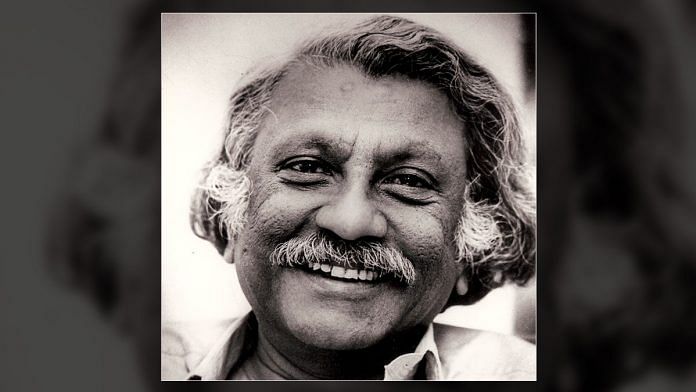Bengaluru: Less than six months before his death, astrophysicist Venkataraman Radhakrishnan, 82, announced he would set sail on a boat named in his French wife’s honour, to circumnavigate the world solo.
This was not to be, but the episode serves as a fitting introduction for a space scientist who deeply loved the deep seas and designed sailboats (and aircraft) as a hobby.
Known widely as ‘Rad’, Radhakrishnan was the son of Nobel laureate C.V. Raman and cousin of Nobel laureate Subrahmanyan Chandrasekhar. However, he was also a renowned astrophysicist in his own right, recognised for expanding the field of radio astronomy as well as his work on pulsars.
On his 90th birth anniversary, ThePrint remembers Venkataraman Radhakrishan.
Education and research
Rad was born in Madras on 18 May 1929 to C.V. Raman and Lokasundari Ammal, a year before his father won the Nobel Prize for physics.
He studied in Chennai before graduating from Mysore University in 1950 with a BSc in physics — for over four decades, until Amsterdam University conferred an honorary doctorate on him in 1996 — this would be the only degree he had.
He subsequently served as a research scholar at the Indian Institute of Science, Bengaluru, before a brief stint with British Acoustic Films, a UK company involved in scientific research into audio and video with the objective of developing better film equipment.
In 1955, aged 26, Rad took up a research assistant’s position at Chalmers Institute of Technology in Sweden, where he focussed on the observation and measurement of neutral hydrogen in interstellar space. Over his three years in the country, he became fluent in Swedish.
In 1958, he moved further West to the California Institute of Technology (Caltech), where he served as a senior research fellow.
At Caltech, he worked on the Owens Valley Radio Observatory, focusing on the polarisation of radio waves and radio interferometry.
He and his team were the first to calculate the magnetic field of Jupiter, caused by the rotation of its interior, from the radio signals emitted by the planet.
He also worked on understanding atomic hydrogen in the Milky Way.
In 1965, Rad moved to the Commonwealth Scientific and Industrial Research Organisation (CSIRO) division of Radio Physics in Sydney, Australia. At the Parkes Observatory, he was involved in a nascent but big project that studied hydrogen in the universe to understand the interstellar medium.
Rad and his collaborators also studied a pulsar called Vela. Pulsars are magnetic rotating neutron stars that emit electromagnetic radiation in pulses.
In the late 1960s, pulsars had just been discovered and Rad’s work contributed to establishing that they were magnetically charged, thus leading to a better understanding of neutron stars.
He carried out detailed surveys on the intergalactic space map, besides studying a huge variety of pulsars.
His comprehensive work made him one of the world’s leading experts on pulsars who established a solid foundation for their study.
Work in India and legacy
After Raman died in 1970, Raman Research Institute, Bengaluru, which he founded to continue his research after his retirement, invited Rad to help shape it.
Rad joined as director in 1972, and, under his leadership, RRI made rapid strides in building a reputation for scientific research, especially in his own field, radio astronomy, as well as liquid crystals, the area of interest for another scientist cousin, Sivaramakrishna Chandrasekhar.
Rad’s legacy in RRI was to break barriers, inculcate an open and free atmosphere, encourage collaboration, and set up necessary infrastructure, especially to stop the separation of theoretical and experimental physics.
He collaborated with other institutes and brought RRI to the forefront in radio astronomy.
Rad was involved in creating the Giant Metrewave Radio Telescope (GMRT) at Pune, with important components built at RRI itself. He worked with the radio telescope at Ooty, and collaborated with the Indian Institute of Astrophysics, Bengaluru, to build the Gauribidanur (Karnataka) and Mauritius radio observatories.
He stepped down from his directorship at RRI in 1994, but stayed on as professor emeritus until his death in 2011.
Rad served on various national and international science committees as well, including a stint (1988-1994) as vice-president of the International Astronomical Union (IAU), a group of professional astronomers from around the world, and was also a foreign fellow of the US National Academy of Sciences and the Royal Swedish Academy.
Adventures and personal life
Growing up, Rad was deeply fascinated by devices and vehicles, and enthusiastic about the design and materials of boats and aircraft.
He loved sailing — while moving to Australia in 1964-65, he famously sailed from the UK, across the Atlantic and Pacific oceans, to Sydney, where immigration officers reportedly “refused to believe him”.
In October 2010, he announced plans to circumnavigate the world solo on a catamaran he had designed, named ‘El da mer’ in a nod to wife Francoise-Dominique Barnard’s French roots.
Rad passed away due to cardiac complications, two months before his 83rd birthday, on 3 March 2011. He was survived by his wife and son.
Also read: Meet Gagandeep Kang, Shimla scientist who’s helping save lives of thousands of Indian kids






